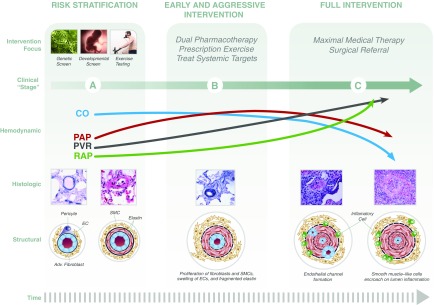Figure 2.
Toward a comprehensive staging approach to pulmonary arterial hypertension (PAH) that emphasizes opportunities for disease prevention. An integrated approach to pulmonary vascular disease considers complex relationships between right ventricular function, pulmonary arterial pathobiology, and cardiopulmonary hemodynamics at rest and with exercise. Collectively, this permits an organization of disease staging in which stage A indicates asymptomatic status despite increased risk and histological/structural abnormalities; stage B indicates symptomatic status at the time of diagnosis; and stage C indicates patients with severe or end-stage disease. This schema may inform appropriate interventions at each stage that are based on observational and randomized clinical trial data. In particular, genetic screening, developmental screening, and exercise testing are assessments supported by empiric data for selected patient subgroups at risk for PAH. Implementation of these strategies may have important ramifications for improving PAH diagnosis timing and implementation of standard-of-care therapy prior to end-stage disease, including up-front combination PAH therapy with an endothelin receptor antagonist and phosphodiesterase type-V inhibitor in treatment-naive patients. Adv. = adventitial; CO = cardiac output; EC = endothelial cell; PAP = pulmonary artery pressure; PVR = pulmonary vascular resistance; RAP = right atrial pressure; SMC = pulmonary artery smooth muscle cell. Concepts from section on structural changes adapted from Reference 1.

